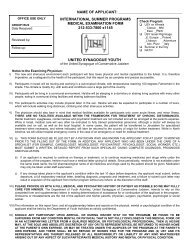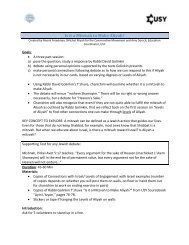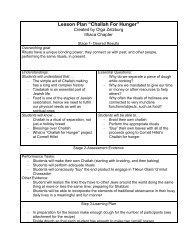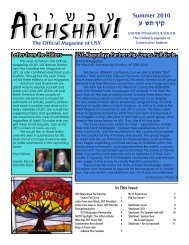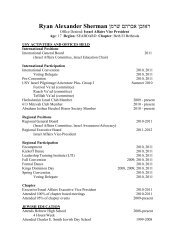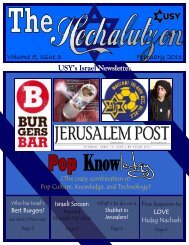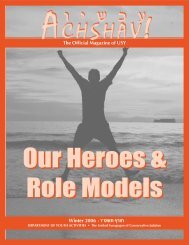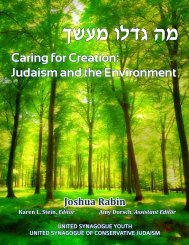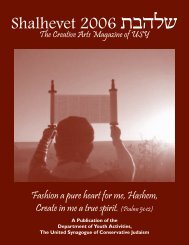2001 - United Synagogue Youth
2001 - United Synagogue Youth
2001 - United Synagogue Youth
- No tags were found...
You also want an ePaper? Increase the reach of your titles
YUMPU automatically turns print PDFs into web optimized ePapers that Google loves.
ShalhevetMy Poland Experienceby Melissa RaphaelIf you asked me at the beginningof the summer of 1999, on USY onWheels, whether I would take a trip toPoland the next summer, I would have said“Yeah right, I’m not crazy, why would Iwant to go to Poland.” This left two Pilgrimagetrips: Spain/Israel Pilgrimage andHeroism and Hope - Italy/Israel Pilgrimage.However, during Friday night dinnerin Texas, I told my best friends Tali andArie that if they held my hand the weekin Poland, I would go with them.I don’t remember what exactlyBunks at Auschwitz. Photo by Dan Roffman. changed my mind, but it must have hadsomething to do with being with 47 otherJewish teenagers who were proud of their heritage like I was. Like many other USYers, Pilgrimage wasone of the most memorable experiences of my life, but my experience had an added dimension. I amthe granddaughter of two Holocaust survivors. My Nona and Nono came from Salonika, Greece, thelargest Sephardic community of that time. Little is known about the Sephardic Holocaust experience,but 96% of that entire community was exterminated, including our entire family. Growing up I heardmy grandparents’ stories at Friday night dinners, Holocaust memorials, and on Rosh Hashanah. UnderSephardic custom, my Nono took an aliyah to the Torah every Rosh Hashanah. After the aliyah, theRabbi recited a long list of names of our family that perished in the Holocaust. Once I decided to goto Poland, it was my first wish to be the first of my immediate family to recite Kaddish and say the longlist of names at the place where they all probably perished.Upon arriving at Auschwitz, I realized my Nona and I had something in common. In 1943, shewas sixteen and arrived at this death camp with her family. In 2000, I was sixteen and arrived at thisdeath camp with 71 committed Jews. It was not what I expected from the stories I heard. When myNona arrived, it was night. She was separated from her entire family and was all alone. She saw thesickly, fearful faces of inmates. She saw the dirty, crowded, and unsanitary conditions of the barracks.When I arrived, it was day time. It was my obligation to be there. I clung to my friends because I couldnot be alone. I saw tourists young and old, of all nationalities. I saw cleaned barracks made intomuseums. Any signs that it was once the most destructive concentration camp were gone. Visually, itwas hard to imagine that it was once a death camp. Yet the one thing that still existed, the one thing myNona and I had in common, was our feelings and emotions. I didn’t need to see an intact death campto feel the horrors and sadness of Auschwitz, to feel that death was all around me.At the end of our day, my group formed a circle to recite our own memorial service. I gave myNono’s Rosh Hashanah list to my head counselor, who recited those names in El Melay Rachamim, theMemorial Prayer. Afterwards, my friend Tali and I went to the side so I could say the Sephardic Kaddish.28



